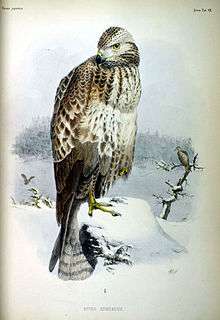Upland buzzard
The upland buzzard (Buteo hemilasius) is a species of bird of prey in the family Accipitridae.
| Upland buzzard | |
|---|---|
 | |
| Scientific classification | |
| Kingdom: | Animalia |
| Phylum: | Chordata |
| Class: | Aves |
| Order: | Accipitriformes |
| Family: | Accipitridae |
| Genus: | Buteo |
| Species: | B. hemilasius |
| Binomial name | |
| Buteo hemilasius | |
Description
This is the largest buzzard and the largest member of the Buteo in the world based on total length and wingspan, though it is roughly equaled in bulk by the North American ferruginous hawk, which is also only marginally smaller going on mean standard measurements. The total length is 57 to 71 cm (22 to 28 in) and wingspan is 143–161 cm (57–64 in).[2][3] Body mass is known to range from 950 to 1,400 g (2.09 to 3.09 lb) in males, with three averaging 1,168 g (2.575 lb), and from 970 to 2,050 g (2.14 to 4.52 lb) in females, with seven averaging 1,581 g (3.486 lb).[2][4] There are both pale and dark morphs. Similar in plumage to others buzzards. Pale morph has lightly marked whitish head, nape and underparts with large brown spots irregularly distributed in upper breast and abdomen. Flanks and sides of the belly dark, tail with greyish centre and dark sides, tail bands prominently dark, with heavier sub-terminal band. Tarsi is fully (or at least three-quarters) feathered brown. Dark morph bird has the upper parts, lower body and wing coverts solid dark, with the flight feather pattern similar to pale morph.[5][6]
Taxonomy and systematics
This species was first described by Temminck and Schlegel in 1844 and is monotypic. Currently considered to form a superspecies with Buteo rufinus as they do not interbreed, though their ranges overlap.
Distribution and status
It is found in Bhutan, China, Hong Kong, India, Pakistan, Iran, Japan, Kazakhstan, North Korea, South Korea, Mongolia, Nepal, Russia, Tajikistan, and Uzbekistan.
Behaviour and ecology
Normally found in open montane grass lands and cultivation in summer, wintering to lower altitudes. Frequently hovers. Hunts from air or ground. Breeds between April and August on crags and ledges of cliffs. Nest is made of sticks and well lined. Feeds on small mammals, birds and insects.[5][6]
References
- BirdLife International (2012). "Buteo hemilasius". IUCN Red List of Threatened Species. 2012. Retrieved 26 November 2013.CS1 maint: ref=harv (link)
- "Raptors of the World" by Ferguson-Lees, Christie, Franklin, Mead & Burton. Houghton Mifflin (2001), ISBN 0-618-12762-3.
- del Hoyo, J; Elliot, A; Sargatal, J (1996). Handbook of the Birds of the World. 3. Barcelona: Lynx Edicions. ISBN 84-87334-20-2.
- Dunning, John B. Jr., ed. (2008). CRC Handbook of Avian Body Masses (2nd ed.). CRC Press. ISBN 978-1-4200-6444-5.
- Rasmussen PC & JC Anderton (2005). Birds of South Asia: The Ripley Guide. Volume 2. Smithsonian Institution & Lynx Edicions. pp. 103–104.
- Baker, ECS (1928). Fauna of British India. Birds. Volume 5 (2nd ed.). Taylor and Francis, London. pp. 140–142.
External links
| Wikimedia Commons has media related to Buteo hemilasius. |
- The Ineternet Bird Collection Upland buzzard
